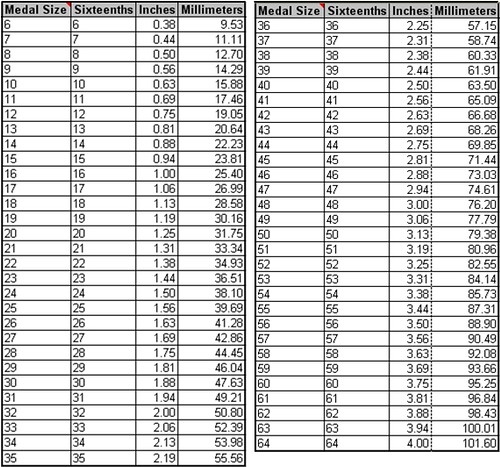
PREV ARTICLE
NEXT ARTICLE
FULL ISSUE
PREV FULL ISSUE
THE AMERICAN MEDAL SCALE Several readers responded to Robert Rightmire's query with information about the old American medal scale. -Editor Pete Smith writes: The old scale to measure medals was based on each point representing one-sixteenth of an inch. Thus a size 22 medal had a diameter of 1-3/8 inch. One inch (size 16) is equal to 25.4 millimeters. One sixteenth of an inch is equal to 1.5875 mm. To make a conversion, just multiply the size by 1.5875. Thus size 22 is 34.925 mm. Anyone familiar with Excel could make a conversions table. There are also web sites that will convert inches to millimeters or do the reverse. Ken Barr also had the answer and was the first to note the So-Called Dollars as a reference. David Gladfelter writes: Baker used what was called the "American scale" which was in sixteenths of an inch. See page vii. Thus a "size 22" medal on the American scale would have a diameter of 22/16" or 1 and 3/8 inches. One inch is about 25 millimeters. So to convert "American scale" to metric, multiply by ~ 1.56 (if I have the arithmetic right, a big if). A size 22 medal on the American scale would thus have a diameter of about 34.32 millimeters. There was no consistency in use of the "American scale" in this country. Low’s catalog of Hard Times tokens published in 1899 gave sizes in millimeters. Betts’s catalog of American colonial medals published in 1894 used the American scale but did not specify it. In the text descriptions of size, Baker, Betts and Low gave numbers only, without reference to scale – American or metric. The American scale is rarely used anymore. It was used by Hibler and Kappen in their book on so-called dollars published in 1963. Harry Waterson writes My knowledge of the measurement method utilizing size 22 comes from the Hibler & Kaplan book So-Called Dollars. In their introduction, they note: Sizes are shown throughout in sixteenths of an inch, next upper size being used if a particular piece is of interim size. Earlier in the introduction, it is noted that one of the criteria for a So-Called Dollar is that it should fall between size 21 and size 28 with exceptions noted. So a very simple mathematical formula will convert any size to mm. Just take any size divide it by 16 and times the answer by 25.4mil.per inch and Bob's your uncle, i.e., 22/16 = 1.375 x 25.4 = 34.92mm. This system is pretty inaccurate in the So-Called Dollar size range as the practice of rounding up to the next sixteenth of an inch can introduce an error ranging from 4.7% to 3.5% (As the size increases the possible error decreases). It is easy to see why this yardstick is rarely used. In fact, the yardstick versus meter issue caused NASA to miss Mars not too long ago. All the best, and thanks for the fine work you do turning out the E-sylum. I look forward to it every week. Ron Benice writes: For quick reference, I use the attached chart, which I created in a spreadsheet and then converted to a graphic.  Wayne Homren, Editor The Numismatic Bibliomania Society is a non-profit organization promoting numismatic literature. See our web site at coinbooks.org. To submit items for publication in The E-Sylum, write to the Editor at this address: whomren@gmail.com To subscribe go to: https://my.binhost.com/lists/listinfo/esylum All Rights Reserved. NBS Home Page Contact the NBS webmaster 
|